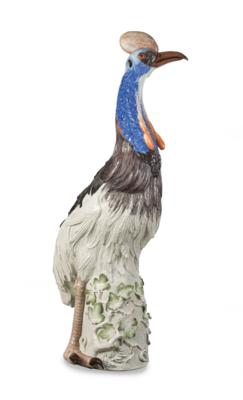A Cassowary, Meissen 1924–1934
porcelain, painted in lifelike colours, life-size sculptural figure of a standing southern cassowary on a tree stump decorated with branches and foliage, height 128 cm, model by Johann Joachim Kaendler (1732), underglaze blue crossed swords mark, partly restored. (GO)
The large-scale animal sculptures are among the most spectacular pieces produced by the Meissen Porcelain Manufactory. The early examples are priceless rarities and these models are still produced by the manufactory in a small number of pieces or on individual order.
This cassowary, called “Vogel Casuarium” in Kaendler’s journal from March 1732, goes back to an extensive group of animal sculptures designed for the famous ‘Japanisches Palais’ of Augustus the Strong. The inventory of the palace of 1733 mentions 296 large animals and 297 large birds. The idea of this sculpture program refers to the tradition of princely menageries, which were part of the basic equipment of a castle of any self-respecting ruler. Here, live exotic animals were kept and put on display, not only to amaze the public, but also to demonstrate the regent's power over the world.
After the Meissen manufactory had proven that it could match and even surpass Asian porcelain in quality, the crowning achievement of the ambition of Augustus the Strong and his manufactory was probably the production of these large-scale animal sculptures, as a menagerie for eternity, so to speak, made of Saxon porcelain.
The success of this ambitious artistic project depended not only on the designs of the model masters, but also, due to the sheer size of the animal figures, on the technical skills in shaping and firing the porcelain. This challenging project was first entrusted to the court sculptor Gottlieb Kirchner and soon to the most famous and influential modeller of the manufactory, Johann Joachim Kaendler.
This 129cm high sculpture is life-size and thus the largest of all surviving Meissen animal figures. It is especially impressive because the depiction of the animal, which is actually native to New Guinea and northern Australia, is one of Kaendler's early works.
Lit.:
Wittwer, Samuel: Die Galerie der Meißner Tiere. Die Menagerie August des Starken für das Japanische Palais, Munich 2004, pp. 186–187 and p. 328.
Esperto: M.A. Georg Ottomeyer
 M.A. Georg Ottomeyer
M.A. Georg Ottomeyer
+43-1-515 60-538
georg.ottomeyer@dorotheum.at
25.04.2024 - 13:00
- Stima:
-
EUR 65.000,- a EUR 80.000,-
Osserva lotto Non osservare più
A Cassowary, Meissen 1924–1934
porcelain, painted in lifelike colours, life-size sculptural figure of a standing southern cassowary on a tree stump decorated with branches and foliage, height 128 cm, model by Johann Joachim Kaendler (1732), underglaze blue crossed swords mark, partly restored. (GO)
The large-scale animal sculptures are among the most spectacular pieces produced by the Meissen Porcelain Manufactory. The early examples are priceless rarities and these models are still produced by the manufactory in a small number of pieces or on individual order.
This cassowary, called “Vogel Casuarium” in Kaendler’s journal from March 1732, goes back to an extensive group of animal sculptures designed for the famous ‘Japanisches Palais’ of Augustus the Strong. The inventory of the palace of 1733 mentions 296 large animals and 297 large birds. The idea of this sculpture program refers to the tradition of princely menageries, which were part of the basic equipment of a castle of any self-respecting ruler. Here, live exotic animals were kept and put on display, not only to amaze the public, but also to demonstrate the regent's power over the world.
After the Meissen manufactory had proven that it could match and even surpass Asian porcelain in quality, the crowning achievement of the ambition of Augustus the Strong and his manufactory was probably the production of these large-scale animal sculptures, as a menagerie for eternity, so to speak, made of Saxon porcelain.
The success of this ambitious artistic project depended not only on the designs of the model masters, but also, due to the sheer size of the animal figures, on the technical skills in shaping and firing the porcelain. This challenging project was first entrusted to the court sculptor Gottlieb Kirchner and soon to the most famous and influential modeller of the manufactory, Johann Joachim Kaendler.
This 129cm high sculpture is life-size and thus the largest of all surviving Meissen animal figures. It is especially impressive because the depiction of the animal, which is actually native to New Guinea and northern Australia, is one of Kaendler's early works.
Lit.:
Wittwer, Samuel: Die Galerie der Meißner Tiere. Die Menagerie August des Starken für das Japanische Palais, Munich 2004, pp. 186–187 and p. 328.
Esperto: M.A. Georg Ottomeyer
 M.A. Georg Ottomeyer
M.A. Georg Ottomeyer
+43-1-515 60-538
georg.ottomeyer@dorotheum.at
|
Hotline dell'acquirente
lun-ven: 09.00 - 18.00
kundendienst@dorotheum.at +43 1 515 60 200 |
| Asta: | Mobili e anitiquariato, vetri e porcellane |
| Tipo d'asta: | Asta in sala con Live Bidding |
| Data: | 25.04.2024 - 13:00 |
| Luogo dell'asta: | Wien | Palais Dorotheum |
| Esposizione: | 13.04. -25.04.2024 |

